

Highly Specialized Labs
Project-Based and hands-on learning is a critical component of the learning environment for all learners in every subject area. Specialized Labs support a variety of functions, from specialized science to robotics and everything in between, and they should be integrated at all grade levels.

CCUSD envisions a flexible framework for making learning environments that adapt over time. Technology is an integral component of today’s educational environment, and it will only expand its influence on both methodologies and content. An increase in the complexity of the work and the equipment being used in society requires specialized equipment to interface with new technologies. At the same time, those technologies are constantly changing, often requiring whole new support systems. Spaces that support future education will need to be both specialized and flexible. CCUSD’s approach is finding the right balance of Multi-Purpose Labs and Highly Specialized Labs. While specialized labs are more prevalent at the secondary school level, many of these programs will continue to filter down to lower grades in the future.
CCUSD is a small district in a tight-knit community that has access to board members, mentors and industry partners. In the robotics after school program, students use engineering skills to write software, program the computer, and assemble the motors. They create 3D models using Computer-aided design (CAD), print in 3D, engrave with laser cutters, weld, do metalwork, do woodwork, install electronics like LED lighting and sensors, and paint the robot working collaboratively. They take great pride in their work. Other skills they must learn for competitions include web design, fundraising, video production for publicity and budgeting. Acquiring these multi-faceted skills leads to several career paths and prepares them for unknown careers because they are honing their expertise at learning. The process involves a high level of accountability and collaboration in which mentors work as “guides on the side” supporting the students in their project-based learning endeavors.
David Stout
Robotics After School
Program Director and Volunteer
Uses
Experiential Learning
Experiential Learning makes learning relevant to students by connecting content with real-life experiences. It is a critical component of the learning environment for all learners in every subject area. It is necessary to integrate specialized labs that support a variety of programs.
Project-Based Learning
Makerspaces, one type of specialized labs, provide flexible space for messy project creation, experiential learning, curricula needing specific equipment or access to water and tools. These spaces can be shared for use with Visual and Performing Arts activities. For example, Performing Arts may use some of the equipment for set design and construction.
Specialized Learning
Highly Specialized Labs support the Career and Technical Education (CTE) programs. These range from a clean, technology rich space to build motherboards, solar panels, and robots to an infrastructure-rich space to support wood-working and metal-working activities.
Key Concepts





Relationships
LEGEND




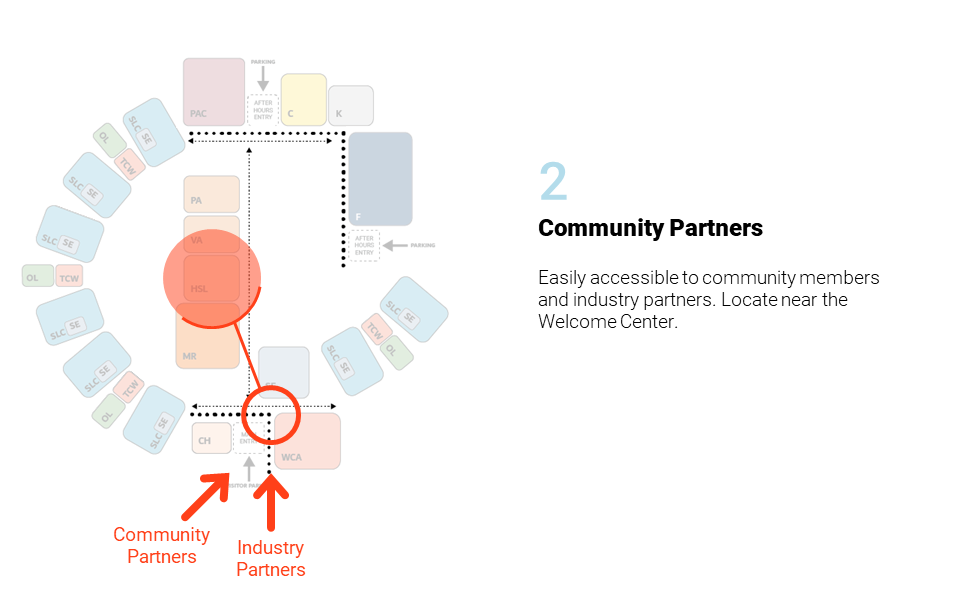

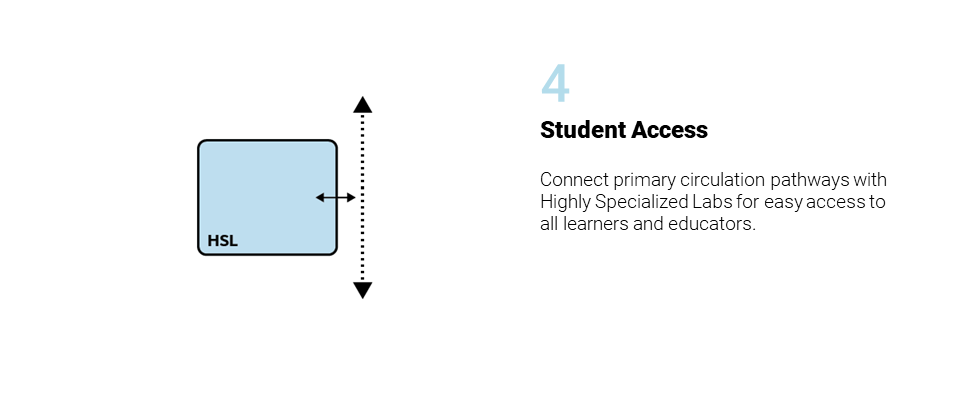
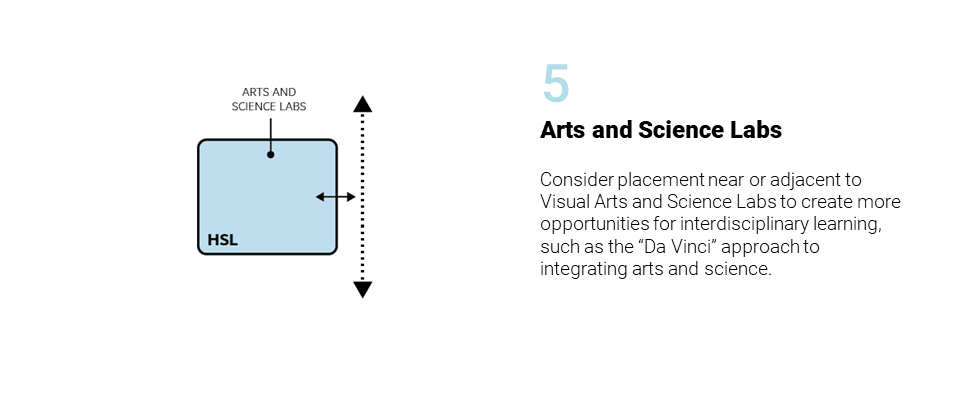
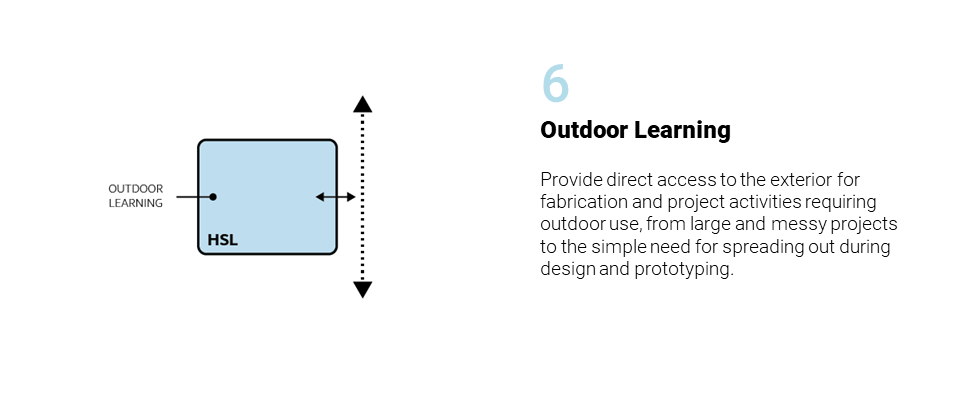
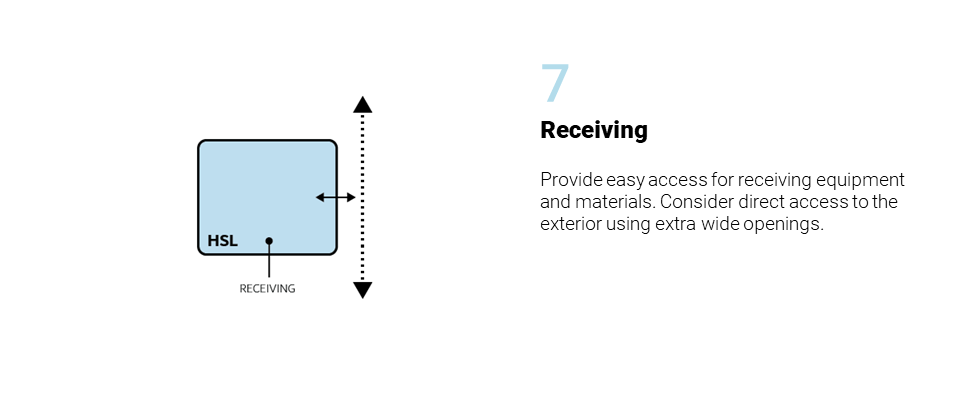
Considerations
Centralized AND Dispersed
Active learning and real-world experiences are important to the learning model for all subjects and all grade levels. The design team will work with each campus community to find the right distribution of centralized and dispersed labs. For example, a Multi-Purpose Lab at all school levels may be integrated into the Small Learning Communities for inquiry-based learning, flexible enough to support dynamic growth and evolution over time. Highly Specialized Labs, from Makerspaces at the elementary level to a suite of design and fab labs in high school, may be centralized to provide easy access and maximum display of the activities within.
Flexible-Specialized Balance
Working with specialized equipment—from fabrication machines to kitchen equipment, are experiences that cannot be replicated otherwise. The mix of highly specialized spaces needs to be balanced with the multi-use and flexible nature these activities require. It is important to understand and develop the ability of these types of spaces to continually adjust over time to support programs and technologies that are not yet created.
Right Size
Consider flexible and operable walls when appropriate to share space and accommodate a variety of groups of learners. Outdoor Learning should be connected directly to the interior lab environments to extend the footprint and give students more space to work.
Learning Continuum
A carefully integrated mix of community and school resources is required to meet the evolutionary aspects of many specialized Career and Technical Education (CTE) programs. While aspects of CTE are more prevalent at the secondary school level, many of these programs will continue to filter down to lower grades in the future. For example, the success of Robotics in high school will lead to a robust program in the middle school. Several elementary schools at CCUSD already have Makerspaces and plan to make them available for after school programs to give students more time for Project-Based Learning.
Infrastructure
Provide additional mechanical and electrical services, exploring overhead power/data and flexible bus-system power to provide maximum flexibility for future programs. Provide sinks and confirm if floor drains are necessary. Consider exposing structure to allow for hanging display of work, and movement of large materials. Design infrastructure to support specific equipment needs.
Interior Design
Use more durable finishes and create acoustical separation from other learning environments to eliminate sound transfer. Programs will require mobile whiteboards to define space necessary for both whole group and small group work. Provide large movable work tables to support material layout space, teaming, and technology as necessary. Tables should be highly durable for project creation. Consider project storage needs. Project storage can be both in walk in closets and along glazing to share work in progress with other students not in the lab to inspire them and make the learning explicit.